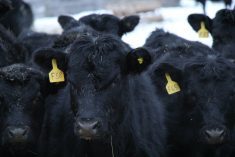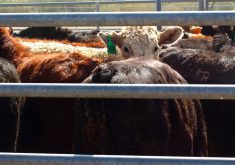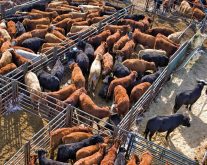As speculation swirls around U.S. President-elect Donald Trump’s promise to renegotiate NAFTA, officials with Canada’s beef industry are taking a measured approach.
They’re not ignoring the possibility of trade disruptions in the U.S., said Ryder Lee, CEO of the Saskatchewan Cattlemen’s Association — “but neither are we lighting our hair on fire yet at each proposal you catch wind of.”
Lee expects to hear plenty of proposals between now and the Jan. 20 inauguration, and even through the next year. “And a lot of the things we’ll hear now are kind of spitballs. They’re waiting to see what sticks and what doesn’t.”
Read Also

U.S. livestock: ‘Cattle on feed’ report supports prices
Chicago cattle futures rose as the USDA’s ‘Cattle on Feed’ report showed inventories two per cent down from a year…
It’s certainly not the beef industry’s first rodeo. The sector has worked for years to reopen borders shut since the first case of BSE was found in an Alberta cow in 2003. And Canada only recently had mandatory country-of-origin labelling (COOL) struck down by the World Trade Organization.
“It’s a garden that needs tending all the time,” Lee said of trade issues such as COOL. But Canada has many staffers in Ottawa and D.C. who learned the ropes during BSE, he said.
Some newly elected officials and their staff also likely have some catching up to do, he acknowledged.
The SCA, however, sends money to the Canadian Cattlemen’s Association “to have those people on the ground, to have those relationships so that they’re not making it up as they go. They don’t have to. Cattle producers’ voices are heard there and understood.”
Those staffers are already talking to members of Congress and administration officials in D.C., Lee said, as well as people connected to Trump’s transition team. In fact, firing up COOL again might already have proved to be “a bit of a lead balloon,” he said.
Lee’s basing that hope on a recent article from MeatingPlace.com, which reported Trump’s agricultural advisory committee has already talked the transition team out of reinstating COOL.
The push for COOL was coming from beef producers at a recent meeting organized by R-CALF, the South Dakota Stockgrowers’ Association and the Independent Beef Association of North Dakota, MeatingPlace reported.
Trade actions such as COOL are always a risk, Lee said. “But the nice thing about that one is it’s fresh enough everybody knows what happened at the WTO, what our retaliation list is.”
Bilateral deals
It looks like “the sun is setting” on the Trans-Pacific Partnership (TPP), said Lee. A Canadian government official has said Canada has until February 2018 to make a final decision on walking away from the deal, the Toronto Star reports.
Trump, however, has promised to drop the multilateral deal between 12 Pacific Rim nations, effectively killing it.
Canada could follow New Zealand’s lead, passing TPP at home to send a signal that we’re not talking protectionism, Lee said.
“The jewel of TPP for us was catching up on access to Japan,” said Lee. Canada had started negotiating a bilateral agreement with Japan, and TPP’s demise could add “a little more fuel to it,” he added.
Ultimately, Lee would like to see better access to Japan’s high-value market for Canadian beef. “Australia has about an 11 per cent advantage into Japan for beef exports. That’s more than your profit a lot of the time.”
Mexico is also an important market for Canadian beef, and China has “exploded” for the industry as Canada has gotten better access, Lee said.
Beyond that, markets depend on cuts, what kind of value chains are set up, which processor is involved, and how they’ll be supplying that business throughout the year.
But while Canada’s beef industry supplies other markets, the U.S. remains an important trading partner.
“A lot of the time it’s our home market that’s most important,” Lee said. “And the U.S., we can service it fresh and on a truck. So those two are always the biggest ones.”
— Lisa Guenther is a field editor for Grainews and Country Guide based at Livelong, Sask. Follow her at @LtoG on Twitter.
















